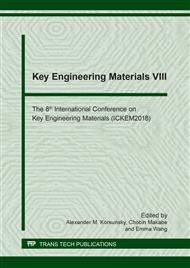[1]
D. Yu MD, et al, Agency for Toxic Substances and Disease Registry Case Studies in Environmental Medicine (CSEM): Chromium Toxicity, (2008).
Google Scholar
[2]
WHO. Guidelines for drinking-water quality: World Health Organization; (2011).
Google Scholar
[3]
Da̧browski, A., Z. Hubicki, P. Podkościelny, and E. Robens, Selective removal of the heavy metal ions from waters and industrial wastewaters by ion-exchange method, Chemosphere 56, no. 2 (2004), 91-106.
DOI: 10.1016/j.chemosphere.2004.03.006
Google Scholar
[4]
Abdel-Aziz, M.H., N.K. Amin, and E.-S.Z. El-Ashtoukhy, Removal of heavy metals from aqueous solutions by liquid cation exchanger in a jet loop contactor, Hydrometallurgy 137 (2013), 126-132.
DOI: 10.1016/j.hydromet.2013.06.003
Google Scholar
[5]
S.A, Ali, and M.H. Fazaelipoor, Evaluation of rhamnolipid (RL) as a biosurfactant for the removal of chromium from aqueous solutions by precipitate flotation, Journal of Environmental Management 165 (2016), 184-187.
DOI: 10.1016/j.jenvman.2015.09.034
Google Scholar
[6]
Pang, Fong M., Pradeep Kumar, Tjoon T. Teng, A.K. Mohd Omar, and Kailas L. Wasewar., Removal of lead, zinc and iron by coagulation–flocculation, Journal of the Taiwan Institute of Chemical Engineers 42, no. 5 (2011), 809-815.
DOI: 10.1016/j.jtice.2011.01.009
Google Scholar
[7]
Huang, Yifeng, Dihua Wu, Xiaodong Wang, Wei Huang, Darren Lawless, and Xianshe Feng, Removal of heavy metals from water using polyvinylamine by polymer-enhanced ultrafiltration and flocculation, Separation and Purification Technology 158 (2016).
DOI: 10.1016/j.seppur.2015.12.008
Google Scholar
[8]
Dabrowski A., Adsorption-From Theory to Practice, Advances in Colloid and Interface Science 93 (2001), 135-224.
Google Scholar
[9]
Zanin, Evandro, Jaqueline Scapinello, Maickson De Oliveira, Cassiano L. Rambo, Francini Franscescon, Lucimaira Freitas, Josiane M. De Mello, Marcio A. Fiori, J.Vladimir Oliveira, and Jacir Dal Magro, Adsorption of heavy metals from wastewater graphic industry using clinoptilolite zeolite as adsorbent, Process Safety and Environmental Protection 105 (January 2017), 194-200.
DOI: 10.1016/j.psep.2016.11.008
Google Scholar
[10]
Abdelfattah, Ibrahim, Adel A. Ismail, Fathy A. Sayed, Ali Almedolab, and K.M. Aboelghait, Biosorption of heavy metals ions in real industrial wastewater using peanut husk as efficient and cost effective adsorbent, Environmental Nanotechnology, Monitoring & Management 6 (December 2016), 176-183.
DOI: 10.1016/j.enmm.2016.10.007
Google Scholar
[11]
Budiman, Faisal, Tan W. Kian, Khairunisak A. Razak, Atsunori Matsuda, and Zainovia Lockman., The Assessment of Cr(VI) Removal by Iron Oxide Nanosheets and Nanowires Synthesized by Thermal Oxidation of Iron in Water Vapour, Procedia Chemistry 19 (2016).
DOI: 10.1016/j.proche.2016.03.057
Google Scholar
[12]
Wang, Xiaoge, Ammonium mediated hydrothermal synthesis of nanostructured hematite (α-Fe2O3) particles, Materials Research Bulletin 47, no. 9 (2012), 2513-2517.
DOI: 10.1016/j.materresbull.2012.05.005
Google Scholar
[13]
Bagheri, Samira, K. G. Chandrappa, and Sharifah Bee Abd Hamid, Generation of Hematite Nanoparticles via Sol-Gel Method, Research Journal of Chemical Sciences 3, no. 7 (May/June 2013), 62-68.
Google Scholar
[14]
Canaria, Michelle L., Jackie L. Ramos, Charles M. Sayson, and Mary D. Balela. Growth of Hematite Nanostructures in Iron Foil for Environmental Cleaning., Solid State Phenomena 266 (2017), 101-104.
DOI: 10.4028/www.scientific.net/ssp.266.101
Google Scholar
[15]
Yuan, L., Yiqian Wang, Rongsheng Cai, Qike Jiang, Jianbo Wang, Boquan Li, Anju Sharma, and G. Zhou, The origin of hematite nanowire growth during the thermal oxidation of iron' Materials Science and Engineering: B 177, no. 3 (2012), 327-336.
DOI: 10.1016/j.mseb.2011.12.034
Google Scholar
[16]
J. Simonin, On the comparison of pseudo-first order and pseudo-second order rate laws in the modeling of adsorption kinetics, Chemical Engineering Journal, vol. 300, pp.254-263, (2016).
DOI: 10.1016/j.cej.2016.04.079
Google Scholar
[17]
L. Largitte and R. Pasquir, A review of the kinetics adsorption models and their application to the adsorption of lead by an activated carbon, Chemical Engineering Research and Design, vol. 107, pp.495-504, (2016).
DOI: 10.1016/j.cherd.2016.02.006
Google Scholar
[18]
Hu J, Chen G, Lo IM, Removal and recovery of Cr (VI) from wastewater by maghemite nanoparticles, Water Research (2005), 39: 4528-4536.
DOI: 10.1016/j.watres.2005.05.051
Google Scholar
[19]
Park HJ, Tavlarides LL, Adsorption of chromium (VI) from aqueous solutions using an imidazole functionalized adsorbent, Industrial & Eng Chem Research 2008; 47: 3401-3409.
DOI: 10.1021/ie7017096
Google Scholar


